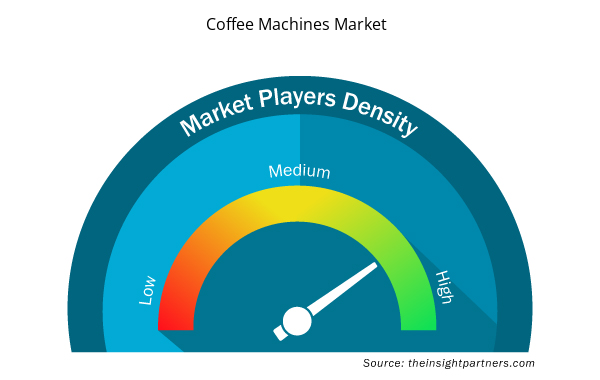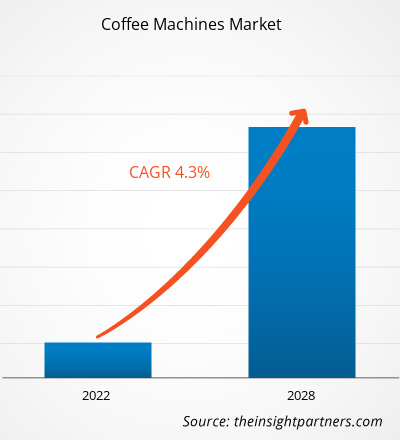[研究报告] 2021 年咖啡机市场规模价值 153.4075 亿美元,预计到 2028 年将达到 205.9679 亿美元;预计 2021 年至 2028 年的复合年增长率为 4.3%。
市场洞察和分析师观点:
咖啡机是一种用来冲泡咖啡的设备。咖啡机有多种类型,例如法式压滤机、意式浓缩咖啡机、滤泡式咖啡机、胶囊和胶囊咖啡机等。每台机器的工作原理都不同。例如,在滤泡式咖啡机中,水会自动滴入加热管并倒在经过过滤器的研磨咖啡上。然而,在胶囊和胶囊咖啡机中,咖啡装在塑料或铝制成的胶囊中,并放在一个小容器中,然后放入咖啡机中冲泡咖啡。企业和机构部门对咖啡机的需求日益增加。这一因素极大地推动了全球咖啡机市场的发展。
增长动力和挑战:
过去几年,由于繁忙的工作日程和延长的工作时间,人们的生活方式发生了巨大变化。由于快节奏的生活方式,人们越来越多地转向方便食品和饮料。在企业界,人们不断面临与工作相关的压力,因此他们希望有空闲时间与同事和朋友共度时光。咖啡是一种用途广泛的饮料,由于其令人陶醉的味道和香气而被广泛饮用。此外,咖啡中的咖啡因有助于改善情绪并激发动力。这一因素极大地推动了全球咖啡行业的发展。咖啡机有助于即时冲泡咖啡,这就是为什么企业界对咖啡机的需求很高的原因。这一因素极大地推动了咖啡机市场的发展。然而,随着人们越来越意识到咖啡的高度成瘾性,他们开始用天然果汁、珍珠奶茶、苏打水等其他饮料代替咖啡。此外,人们越来越意识到高咖啡因摄入对健康的负面影响,这也阻碍了个人对咖啡的需求。预计这些因素将对咖啡消费产生负面影响,从而阻碍预测期内对咖啡机的需求。
定制此报告以满足您的需求
您可以免费定制任何报告,包括本报告的部分内容、国家级分析、Excel 数据包,以及为初创企业和大学提供优惠和折扣
- 获取此报告的关键市场趋势。这个免费样品将包括数据分析,从市场趋势到估计和预测。
报告细分和范围
“全球咖啡机市场”根据类型、类别、最终用户和地理位置进行细分。根据类型,咖啡机市场细分为滤泡咖啡机、浓缩咖啡机、胶囊和豆荚咖啡机等。根据类别,市场分为手动和自动与半自动。根据最终用户,咖啡机市场细分为住宅和非住宅。根据地理位置,咖啡机市场细分为北美(美国、加拿大和墨西哥)、欧洲(德国、法国、意大利、英国、俄罗斯和欧洲其他地区)、亚太地区(澳大利亚、中国、日本、印度、韩国和亚太地区其他地区)、中东和非洲(南非、沙特阿拉伯、阿联酋和中东和非洲其他地区)以及南美洲和中美洲(巴西、阿根廷和南美洲和中美洲其他地区)
节段分析:
根据最终用户,咖啡机市场分为住宅和商业。住宅部分在咖啡机市场中占有重要份额,预计在预测期内将实现显着增长。咖啡的普及率不断提高以及对不同类型的咖啡烘焙和冲泡的兴趣日益浓厚,推动了整个住宅领域对咖啡机的需求。此外,由于 COVID-19 的爆发,人们被要求待在家里,所有餐饮店都关闭。这引发了家庭对咖啡机的需求,尤其是在发达国家。所有这些因素都有可能推动全球咖啡机市场的发展。
区域分析:
根据地理位置,咖啡机市场分为五个主要区域:北美、欧洲、亚太地区、南美和中美以及中东和非洲。全球咖啡机市场以欧洲为主,2022 年市场规模为 49.5177 亿美元。北美是第二大贡献者,在全球市场占有 20% 以上的份额。预计亚太地区在预测期内将以超过 5% 的复合年增长率实现可观增长。北美国家,尤其是美国的每日咖啡摄入量增加,推动了对咖啡机的需求。据美国国家咖啡协会 (NCA) 称,62% 的美国人每天都喝咖啡。此外,由于快节奏的生活方式导致的随时随地消费趋势上升,也推动了北美非住宅领域对咖啡机的需求。
行业发展和未来机遇
以下列出了咖啡机市场主要参与者采取的各种举措:
- 2023 年 3 月,著名咖啡机制造商之一德龙推出了 Truerew,这是一款全自动滴滤咖啡机,无需测量咖啡和进行任何猜测,让消费者享受新鲜研磨的优质咖啡体验。
- 2020 年 10 月,Nespresso Professional 在其 Nespresso Momento 咖啡机中推出了新的非接触式功能,这将在 COVID-19 疫情后为工作场所提供增强的安全性。
- 2022 年 3 月,总部位于澳大利亚的家用咖啡设备制造商 Breville Group 宣布收购总部位于意大利的专业消费者浓缩咖啡设备公司 Lelit。Lelit 的家用浓缩咖啡机产品组合是对 Breville Group 现有的家用咖啡设备产品组合的补充。此次收购将帮助该公司满足大量受众的需求,扩大其消费者覆盖范围并提高收入。
- 2021 年 3 月,德龙收购了瑞士咖啡机制造商 Eversys 剩余的 60% 股份。该公司拥有一系列全自动浓缩咖啡机。收购该公司将有助于德龙扩大其产品线并满足不同地区的大量消费者的需求。
Covid-19的影响:
COVID-19 疫情影响了各国几乎所有行业。北美、欧洲、亚太地区 (APAC)、南美和中美 (SAM) 以及中东和非洲 (MEA) 的封锁、旅行限制和企业关闭阻碍了多个行业的增长,包括消费品行业。制造部门的关闭扰乱了全球供应链、制造活动、交付时间表以及必需品和非必需品销售。2020 年,各公司的产品交付延迟,产品销量下滑。由于疫情引发的经济衰退,消费者在购买决策方面变得更加谨慎和挑剔。由于收入较低和收入前景不确定,消费者大幅减少了非必需品的购买,尤其是在发展中地区。由于疫情初期消费者需求减少,许多咖啡机制造商面临利润下降。然而,到 2021 年底,许多国家已经完全接种疫苗,政府宣布放宽包括封锁和旅行禁令在内的某些规定。人们开始前往不同的地方,这增加了机场和火车站对咖啡的需求,从而推动了咖啡机的需求。所有这些因素都对不同地区的咖啡机市场的增长产生了积极影响。
咖啡机市场区域洞察
Insight Partners 的分析师已详尽解释了预测期内影响咖啡机市场的区域趋势和因素。本节还讨论了北美、欧洲、亚太地区、中东和非洲以及南美和中美洲的咖啡机市场细分和地理位置。

- 获取咖啡机市场的区域特定数据
咖啡机市场报告范围
| 报告属性 | 细节 |
|---|---|
| 2021 年市场规模 | 153.4亿美元 |
| 2028 年市场规模 | 206亿美元 |
| 全球复合年增长率(2021 - 2028) | 4.3% |
| 史料 | 2019-2020 |
| 预测期 | 2022-2028 |
| 涵盖的领域 | 按咖啡机市场规模和预测
|
| 覆盖地区和国家 | 北美
|
| 市场领导者和主要公司简介 |
|
市场参与者密度:了解其对商业动态的影响
咖啡机市场正在快速增长,这得益于终端用户需求的不断增长,而这些需求又源于消费者偏好的不断变化、技术进步以及对产品优势的认识不断提高等因素。随着需求的增加,企业正在扩大其产品范围,进行创新以满足消费者的需求,并利用新兴趋势,从而进一步推动市场增长。
市场参与者密度是指在特定市场或行业内运营的企业或公司的分布情况。它表明在给定市场空间中,相对于其规模或总市场价值,有多少竞争对手(市场参与者)存在。
在咖啡机市场运营的主要公司有:
- Keurig Green Mountain, Inc.
- 罗伯特·博世有限公司
- 伊莱克斯公司
- 意利咖啡
- 荷兰皇家飞利浦公司
免责声明:上面列出的公司没有按照任何特定顺序排列。

- 了解咖啡机市场顶级关键参与者概况
竞争格局和重点公司:
全球咖啡机市场的一些知名企业包括 Keurig Green Mountain, Inc.;Robert Bosch GmbH;Electrolux AB;illycaffè SpA;Koninklijke Philips NV;Krups GmBH (Groupe SEB);Morphy Richards;Nestlé SA;Panasonic Corporation;LUIGI LAVAZZA SPA;De'Longhi Appliances Srl 等。这些企业提供具有创新功能和冲泡技术的尖端咖啡机,为消费者带来卓越的咖啡体验。
- 历史分析(2 年)、基准年、预测(7 年)及复合年增长率
- PEST 和 SWOT 分析
- 市场规模价值/数量 - 全球、区域、国家
- 行业和竞争格局
- Excel 数据集


- Wire Harness Market
- Playout Solutions Market
- Medical Collagen Market
- Semiconductor Metrology and Inspection Market
- Identity Verification Market
- Aerospace Forging Market
- Railway Braking System Market
- Social Employee Recognition System Market
- Rare Neurological Disease Treatment Market
- Bioremediation Technology and Services Market

Report Coverage
Revenue forecast, Company Analysis, Industry landscape, Growth factors, and Trends

Segment Covered
This text is related
to segments covered.

Regional Scope
North America, Europe, Asia Pacific, Middle East & Africa, South & Central America

Country Scope
This text is related
to country scope.
常见问题
The major players operating in the global coffee machines market are Keurig Green Mountain, Inc. Robert Bosch Gmbh; Electrolux Ab.; Illycaffè S.P.A.; Koninklijke Philips N.V; Krups Gmbh; Morphy Richards; Nestlé S.A.; Panasonic Corporation; and Luigi Lavazza S.P.A among many others.
Coffee machines are used to brew coffee from ground coffee, coffee beans or capsules. They are available in various sizes and shapes as well as in different type of models which includes filter coffee machines, espresso coffee machines, capsule and pod coffee machines, and others. They are also available in manual, automatic and semi-automatic variants. They are used in various residential and non-residential applications such as office spaces, airports, cafeterias and others.
Espresso has higher caffeine levels per ounce over regular coffee and is very strong. Although quite popular in Europe, especially Italy, they have been witnessing increased demand in other regions such as North America and Asia Pacific. Increasing preference for the taste as well the wide availability of different espresso machines for residential applications have significantly propelled the demand for espresso machines.
Asia Pacific region is an area of tremendous opportunity for the global coffee machines market. The region is a traditionally tea consuming region and the penetration of coffee machines is low compared to the developed economies of Europe and North America. Recent shift in preference for coffee over tea has propelled the demand for coffee machines. Large number of young population is also a major contributor towards the growth of the coffee machines market in Asia Pacific.
Capsule and pod coffee machines have been witnessing significant growth across the globe. The ease of usage and the availability of various flavors of coffee have driven the adoption of capsule and pod coffee machines for use in homes and small offices. However, the traditional coffee brewers that prefer freshly ground coffee pose a restraint to the capsule and pod coffee machines market.
Automatic and semi-automatic coffee machines are expected to grow significantly over the forecast period. Increasing number of new coffee enthusiasts and shift in preference from traditionally tea drinking regions such as Asia Pacific have fueled the adoption of automatic and semi-automatic coffee machines. The ease of usage and convenience for home brewing is a major factor propelling the adoption of automatic and semi-automatic coffee machines.
Trends and growth analysis reports related to Consumer Goods : READ MORE..
The List of Companies - Coffee Machines Market
- Keurig Green Mountain, Inc.
- Robert Bosch Gmbh
- Electrolux Ab.
- Illycaffè S.P.A.
- Koninklijke Philips N.V.
- Krups Gmbh
- Morphy Richards
- Nestlé S.A.
- Panasonic Corporation
- Luigi Lavazza S.P.A.
The Insight Partners performs research in 4 major stages: Data Collection & Secondary Research, Primary Research, Data Analysis and Data Triangulation & Final Review.
- Data Collection and Secondary Research:
As a market research and consulting firm operating from a decade, we have published and advised several client across the globe. First step for any study will start with an assessment of currently available data and insights from existing reports. Further, historical and current market information is collected from Investor Presentations, Annual Reports, SEC Filings, etc., and other information related to company’s performance and market positioning are gathered from Paid Databases (Factiva, Hoovers, and Reuters) and various other publications available in public domain.
Several associations trade associates, technical forums, institutes, societies and organization are accessed to gain technical as well as market related insights through their publications such as research papers, blogs and press releases related to the studies are referred to get cues about the market. Further, white papers, journals, magazines, and other news articles published in last 3 years are scrutinized and analyzed to understand the current market trends.
- Primary Research:
The primarily interview analysis comprise of data obtained from industry participants interview and answers to survey questions gathered by in-house primary team.
For primary research, interviews are conducted with industry experts/CEOs/Marketing Managers/VPs/Subject Matter Experts from both demand and supply side to get a 360-degree view of the market. The primary team conducts several interviews based on the complexity of the markets to understand the various market trends and dynamics which makes research more credible and precise.
A typical research interview fulfils the following functions:
- Provides first-hand information on the market size, market trends, growth trends, competitive landscape, and outlook
- Validates and strengthens in-house secondary research findings
- Develops the analysis team’s expertise and market understanding
Primary research involves email interactions and telephone interviews for each market, category, segment, and sub-segment across geographies. The participants who typically take part in such a process include, but are not limited to:
- Industry participants: VPs, business development managers, market intelligence managers and national sales managers
- Outside experts: Valuation experts, research analysts and key opinion leaders specializing in the electronics and semiconductor industry.
Below is the breakup of our primary respondents by company, designation, and region:

Once we receive the confirmation from primary research sources or primary respondents, we finalize the base year market estimation and forecast the data as per the macroeconomic and microeconomic factors assessed during data collection.
- Data Analysis:
Once data is validated through both secondary as well as primary respondents, we finalize the market estimations by hypothesis formulation and factor analysis at regional and country level.
- Macro-Economic Factor Analysis:
We analyse macroeconomic indicators such the gross domestic product (GDP), increase in the demand for goods and services across industries, technological advancement, regional economic growth, governmental policies, the influence of COVID-19, PEST analysis, and other aspects. This analysis aids in setting benchmarks for various nations/regions and approximating market splits. Additionally, the general trend of the aforementioned components aid in determining the market's development possibilities.
- Country Level Data:
Various factors that are especially aligned to the country are taken into account to determine the market size for a certain area and country, including the presence of vendors, such as headquarters and offices, the country's GDP, demand patterns, and industry growth. To comprehend the market dynamics for the nation, a number of growth variables, inhibitors, application areas, and current market trends are researched. The aforementioned elements aid in determining the country's overall market's growth potential.
- Company Profile:
The “Table of Contents” is formulated by listing and analyzing more than 25 - 30 companies operating in the market ecosystem across geographies. However, we profile only 10 companies as a standard practice in our syndicate reports. These 10 companies comprise leading, emerging, and regional players. Nonetheless, our analysis is not restricted to the 10 listed companies, we also analyze other companies present in the market to develop a holistic view and understand the prevailing trends. The “Company Profiles” section in the report covers key facts, business description, products & services, financial information, SWOT analysis, and key developments. The financial information presented is extracted from the annual reports and official documents of the publicly listed companies. Upon collecting the information for the sections of respective companies, we verify them via various primary sources and then compile the data in respective company profiles. The company level information helps us in deriving the base number as well as in forecasting the market size.
- Developing Base Number:
Aggregation of sales statistics (2020-2022) and macro-economic factor, and other secondary and primary research insights are utilized to arrive at base number and related market shares for 2022. The data gaps are identified in this step and relevant market data is analyzed, collected from paid primary interviews or databases. On finalizing the base year market size, forecasts are developed on the basis of macro-economic, industry and market growth factors and company level analysis.
- Data Triangulation and Final Review:
The market findings and base year market size calculations are validated from supply as well as demand side. Demand side validations are based on macro-economic factor analysis and benchmarks for respective regions and countries. In case of supply side validations, revenues of major companies are estimated (in case not available) based on industry benchmark, approximate number of employees, product portfolio, and primary interviews revenues are gathered. Further revenue from target product/service segment is assessed to avoid overshooting of market statistics. In case of heavy deviations between supply and demand side values, all thes steps are repeated to achieve synchronization.
We follow an iterative model, wherein we share our research findings with Subject Matter Experts (SME’s) and Key Opinion Leaders (KOLs) until consensus view of the market is not formulated – this model negates any drastic deviation in the opinions of experts. Only validated and universally acceptable research findings are quoted in our reports.
We have important check points that we use to validate our research findings – which we call – data triangulation, where we validate the information, we generate from secondary sources with primary interviews and then we re-validate with our internal data bases and Subject matter experts. This comprehensive model enables us to deliver high quality, reliable data in shortest possible time.


 获取此报告的免费样本
获取此报告的免费样本